
Black Sun International Forum (BSIF)
|
| | | Japanese kimono |  |
| | | Author | Message |
|---|
#Nurarihyon#
天照大御神

Posts : 243
Join date : 2010-10-17
Age : 32
Location : Where the world ends
 |  Subject: Japanese kimono Subject: Japanese kimono  Fri Oct 22, 2010 5:56 am Fri Oct 22, 2010 5:56 am | |
| Part One
Let's see how to make that topic enjoyable for reading.I'm not going to list the whole history of the Japanese kimono.But,I'll write that well-world-known Asian tradition as if I am an user,ready to learn interesting facts about the Japanese tradition clothes.
From where to start? 
Well,first of all,let's see the character used for the word "Kimono"- (着物).It exactly means "something to wear".But,there is an interesting thing,the kimono has another name,it's "Gofuku"-(呉服).It means "clothes of Wu",literally.Those who are deeply informed with Asian culture would probably notice something.-Yes,the second name is kinda Chinese one.
Just because the earliest kimono were heavily influenced by traditional Han Chinese clothing, known today as "hanfu"- (漢服,in Japanese-"kanfuku").
Traditionally, kimono are sewn by hand, but even machine-made kimono require substantial hand-stitching. Kimono fabrics are also frequently hand made and hand decorated. Various techniques such as "yuuzen" dye resist are used for applying decoration and patterns to the base cloth. Repeating patterns that cover a large area of a kimono are traditionally done with the yuuzen resist technique and a stencil. Over time there have been many variations in color, fabric and style.
The kimono and obi(I'll explain what "obi" means) are traditionally made of silk, silk brocade, silk crepes (such as chirimen) and satin weaves (such as rinzu). Modern kimonos are also widely available in less-expensive easy-care fabrics such as rayon, cotton sateen, cotton, polyester and other synthetic fibers. Silk is still considered the ideal fabric.
Little by little,the formal kimono was replaced by the more convenient Western clothes and "yukata"- (浴衣) as everyday wear.It's a Japanese garment, a casual summer kimono usually made of cotton. People wearing yukata are a common sight in Japan at fireworks displays, bon-odori- (盆踊り - (bon dance),the typical Bon dance involves people lining up in a circle around a high wooden scaffold made especially for the festival called a 'yagura' festivals, and other summer events.).The yukata is also frequently worn after bathing at traditional Japanese inns. Though their use is not limited to after-bath wear, yukata literally means bath(ing) clothes.
Well,I think,I should explain the parts of a kimono.
Parts of a Kimono
*Douura (胴裏) upper lining on a woman's kimono;
*Eri (衿) collar;
*Fuki hem guard;
*Furi sleeve below the armhole;
*Maemigoro (前身頃) front main panel,excluding sleeves;
(Covering portion of the other side of the back maemigoro is divided into "right maemigoro" and "left maemigoro")
*Miyatsukuchi opening under the sleeve;
*Okumi (衽) front inside panel situated on the front edge of the left and right, excluding the sleeve of a kimono,Until the collar, down to the bottom of the dress goes, up and down part of the strip of cloth.Have sewn the front body;
*Sode (袖) sleeve;
*Sodeguchi (袖口) sleeve opening;
*Sodetsuke (袖付) kimono armhole;
*Susomawashi (裾回し) lower lining;
*Tamoto (袂) sleeve pouch;
*Tomoeri (共衿) over-collar (collar protector);
*Uraeri (裏襟) inner collar;
* Ushiromigoro (後身頃) back main panel:excluding sleeves.
(Covering the back portion. They are basiccally sewn back-centered, and consist of "right ushiromigoro" and "left ushiromigoro" But for wool fabric, ushiro migoro consists of 1 clothes.)

Moving to the next main thing about kimono.
There are woman's kimono and man's ones.Let me list down them.First the ladies,please. *chuckles*
Woman's kimono
Choosing an appropriate type of kimono requires knowledge of the garment's symbolism and subtle social messages, reflecting the woman's age, marital status, and the level of formality of the occasion!

*Furisode - (振袖),furisode literally translates as swinging sleeves—the sleeves of furisode average between 39 and 42 inches (1,100 mm) in length. Furisode are the most formal kimono for unmarried women, with colorful patterns that cover the entire garment. They are usually worn at coming-of-age ceremonies (seijin shiki) and by unmarried female relatives of the bride at weddings and wedding receptions.

*Houmongi - (訪問着),literally translates as "visiting wear". Characterized by patterns that flow over the shoulders, seams and sleeves, houmongi rank slightly higher than their close relative, the tsukesage. Houmongi may be worn by both married and unmarried women; often friends of the bride will wear houmongi at weddings (except relatives!) and receptions. They may also be worn to formal parties.
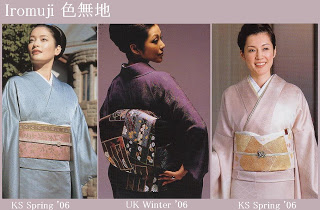
*Iromuji - (色無地),single-colored kimono that may be worn by married and unmarried women. They are mainly worn to tea ceremonies. The dyed silk may be figured (rinzu, similar to jacquard), but has no differently colored patterns.

*Komon - (小紋),"fine pattern". Kimono with a small, repeated pattern throughout the garment. This style is more casual and may be worn around town, or dressed up with a formal obi for a restaurant. Both married and unmarried women may wear komon.

*Mofuku - Mofuku is traditional Japanese kimono which is worn when you express sadness, for example, at funeral or Houji (Buddhist memorial service).Due to white being symbolic of death in Japan, the mofuku was formerly a white garment; however, the modern mofuku is now a black garment, to contrast with the white kimono of the dead.The completely black mourning ensemble is usually reserved for family and others that are close to the deceased. For others, it is customary to wear a colored iromuji with black accessories, to symbolize that they are in mourning but are not particularly close to the deceased.
(Tomesode)
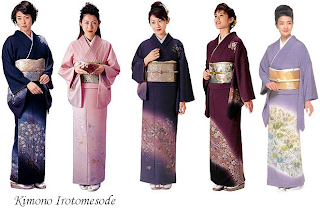
*Irotomesode - (色留袖),single-color kimono, patterned only below the waistline. Irotomesode are slightly less formal than kurotomesode, and are worn by married women, usually close relatives of the bride and groom at weddings. An irotomesode may have three or five kamon.

*Kurotomesode - (黒留袖),a black kimono patterned only below the waistline, kurotoroko are the most formal kimono for married women. They are often worn by the mothers of the bride and groom at weddings. Kurotomesode usually have five kamon printed on the sleeves, chest and back of the kimono.

*Tsukesage - (付け下げ),has more modest patterns that cover a smaller area—mainly below the waist—than the more formal hōmongi. They may also be worn by married women.The differences from houmongi is the size of pattern, seam connection, and not same clothes at inside and outside at "hakke".As demi-toilet, not used in important occasion, but light pattarned houmongi is more rated than classic patterned tsukesage. General tsukesage is often used for party, not ceremony.
(Uchikake)

*Uchikake is a highly formal kimono worn only by a bride or at a stage performance. The Uchikake is often heavily brocaded and is supposed to be worn outside the actual kimono and obi, as a sort of coat. One therefore never ties the obi around the uchikake. It is supposed to trail along the floor, this is also why it is heavily padded along the hem. The uchikake of the bridal costume is either white or very colorful often with red as the base color.
(Susohiki /Hikizuri)
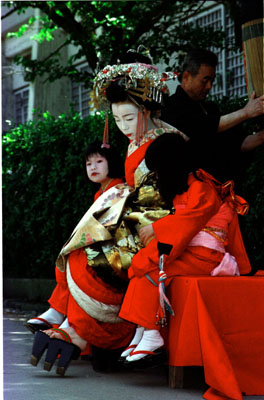
Women dressed as maiko (apprentice geisha), wearing specially tailored "maiko-style" furisode kimonos with tucks in sleeves and at shoulders
The susohiki is mostly worn by geisha or by stage performers of the traditional Japanese dance. It is quite long, compared to regular kimono, because the skirt is supposed to trail along the floor. Susohiki literally means "trail the skirt". Where a normal kimono for women is normally 1.5–1.6 m (4.7–5.2 ft) long, a susohiki can be up to 2 m (6.3 ft) long. This is also why geisha and maiko lift their kimono skirt when walking outside, also to show their beautiful under-kimono.
| |
|   | | #Nurarihyon#
天照大御神

Posts : 243
Join date : 2010-10-17
Age : 32
Location : Where the world ends
 |  Subject: Re: Japanese kimono Subject: Re: Japanese kimono  Fri Oct 22, 2010 4:35 pm Fri Oct 22, 2010 4:35 pm | |
| Part Two
I had to leave earlier today,but! I am here,ready to post .
So,I left the thread with the woman's kimono list completed.That means only one,the next is..
Man's kimono
In contrast to woman's kimono, man's kimono outfits are far simpler, typically consisting of five pieces, not including footwear.
Man's kimono sleeves are attached to the body of the kimono with no more than a few inches unattached at the bottom, unlike the woman's style of very deep sleeves mostly unattached from the body of the kimono. Man's sleeves are less deep than woman's kimono sleeves to accommodate the obi around the waist beneath them, whereas on a woman's kimono, the long, unattached bottom of the sleeve can hang over the obi without getting in the way.
Jin-Haori - Kimono tabards for armoured Samurai.
In the modern era, the principal distinctions between men's kimono are in the fabric. The typical man's kimono is a subdued, dark color; black, dark blues, greens, and browns are common. Fabrics are usually matte. Some have a subtle pattern, and textured fabrics are common in more casual kimono. More casual kimono may be made in slightly brighter colors, such as lighter purples, greens and blues. Sumo wrestlers have occasionally been known to wear quite bright colors such as fuchsia.
The most formal style of kimono is plain black silk with five kamon on the chest, shoulders and back. Slightly less formal is the three-kamon kimono. These are usually paired with white undergarments and accessories.
Accessories and related garments

Datejime or datemaki - (伊達締め) is a wide under-sash used to tie the nagajuban and the outer kimono and hold them in place.

Eri-sugata or kantan eri or date eri - (衿姿) is a dettatched collar that can be worn instead of a nagajuban in summer, when it can be too hot to comfortably wear a nagajuban. It replaces the nagajuban collar in supporting the kimono's collar.
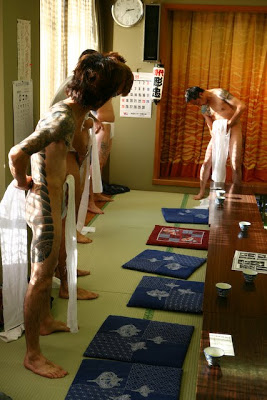
Fundoshi - (褌) is the traditional Japanese undergarment (loin cloth) for adult males, made from a length of cotton.
 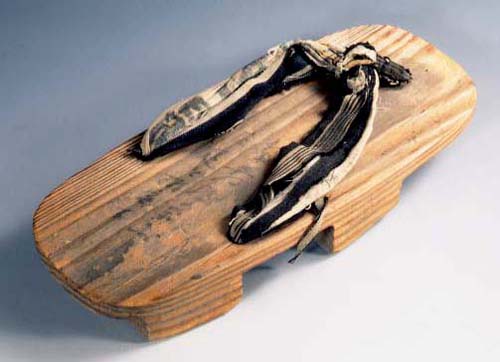
Geta - (下駄) are wooden sandals worn by men and women with yukata. One unique style is worn solely by geisha.

Hakama - (袴) is a divided (umanoribakama) or undivided skirt (andonbakama) which resembles a wide pair of trousers, traditionally worn by men but contemporarily also by women in less formal situations. It is also worn in certain martial arts such as aikido. A hakama typically is pleated and fastened by ribbons, tied around the waist over the obi. Man's hakama also have a koshi ita, which is a stiff or padded part in the lower back of the wearer. Hakama are worn in several budo arts such as aikido, kendo, iaidou and naginata. Hakama are often worn by women at college graduation ceremonies, and by Miko on shinto shrines. Depending on the pattern and material, hakama can range from very formal to visiting wear.

Hanten - (袢纏) is the worker's version of the more formal haori. Often padded for warmth, as opposed to the somewhat lighter happi;

Haori - (羽織) is a hip- or thigh-length kimono-like jacket, which adds formality to an outfit. Haori were originally worn only by men, until it became a fashion for women in the Meiji period. They are now worn by both men and women. Man's haori are typically shorter than woman's;
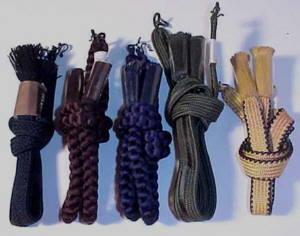
Haori-himo - (羽織紐) is a tasseled, woven string fastener for haori. The most formal color is white;

Happi - (法被) is a type of haori traditionally worn by shop keepers and is now associated mostly with festivals;
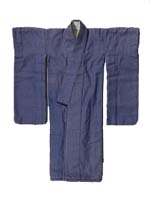
Hiyoku - (ひよく) is a type of under-kimono, historically worn by women beneath the kimono. Today they are only worn on formal occasions such as weddings and other important social events. High class kimonos may have extra layers of lining to emulate the appearance of hiyoku worn beneath;

Hadajuban - (肌襦袢) is a thin garment similar to an undershirt. It is worn under the nagajuban;

Nagajuban - (長襦袢, or simply juban) is a kimono-shaped robe worn by both men and women beneath the main outer garment.Since silk kimono are delicate and difficult to clean, the nagajuban helps to keep the outer kimono clean by preventing contact with the wearer's skin. Only the collar edge of the nagajuban shows from beneath the outer kimono.[15] Many nagajuban have removable collars, to allow them to be changed to match the outer garment, and to be easily washed without washing the entire garment. While the most formal type of nagajuban are white, they are often as beautifully ornate and patterned as the outer kimono. Since man's kimono are usually fairly subdued in pattern and color, the nagajuban allows for discreetly wearing very striking designs and colors.
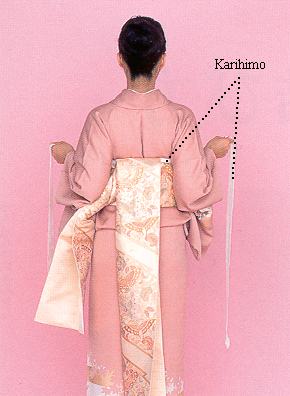
Karihimo, koshihimo - (腰紐) is a narrow sash used to aid in dressing up, often made of silk or wool. They are used to hold virtually anything in place during the process of dressing up, and can be used in many ways depending on what is worn. Some of the karihimos are removed after datejime or obi have been tied, while others remain worn beneath the layers of the dress. The karihimo that is worn around the hips to create the extra fold or ohashori in woman's kimono is called koshihimo, literally "hip ribbon".

Netsuke is an ornament worn suspended from the man's obi.

Obi - (帯) is the sash worn with kimono.

Obi-ita or mae-ita - (帯板) is a thin board, often fabric-covered, that is worn beneath the woman's obi in front to keep the obi from getting creased.
[img]http://farm4.static.flickr.com/3377/3282190495_5091a5a500.jpg[img]
Obiage - (帯揚げ) is an accessory for woman's obi, a sash that is tied around the top edge of the obi and which covers the obimakura "pillow" and may keep the upper part of the obi musubi "knot" in place.

Obimakura - (帯枕) is a small pillow used to give volume and shape to the female obi styles.
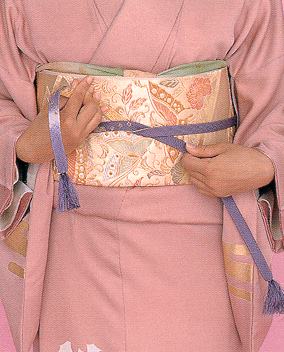
Obijime - (帯締め) is a narrow ribbon or cord worn around woman's obi. It is necessary to hold the popular taiko musubi in place, and doubles as a decorative element.

Samue - (作務衣) are the everyday clothes for a male Zen Buddhist monk, and the favored garment for shakuhachi players.

Susoyoke - (裾除け) is a thin half-slip-like piece of underwear worn by women under the nagajuban

Tabi - (足袋) are ankle-high, divided-toe socks usually worn with zōri or geta. There also exist sturdier, boot-like jikatabi, which are used for example to fieldwork.

Waraji - (草鞋) are straw rope sandals which are mostly worn by monks.

Yukata (浴衣) is an unlined kimono-like garment for summer use, usually made of cotton, linen, or hemp. Yukata are strictly informal, most often worn to outdoor festivals, by men and women of all ages. They are also worn at onsen (hot spring) resorts, where they are often provided for the guests in the resort's own pattern.
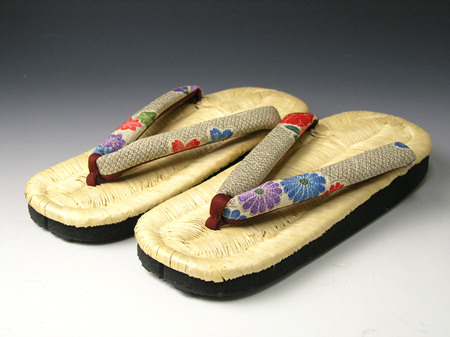
Zouri - (草履) are traditional sandals worn by both men and women, similar in design to flip-flops. Their formality ranges from strictly informal to fully formal. They are made of many materials, including cloth, leather, vinyl and woven grass, and can be highly decorated or very simple.
Well,I tried my best to keep that post as an interesting one.
It's hard to imagine sometimes what kimono looks like,but once wearing it,one won't ever forget it,believe me.
| |
|   | | | | Japanese kimono |  |
|
Similar topics |  |
|
| | Permissions in this forum: | You cannot reply to topics in this forum
| |
| |
| |
|
